Leadership for Addressing Nursing Burnout and Improving Patient Safety
VerifiedAdded on 2022/10/07
|7
|1401
|23
Presentation
AI Summary
This presentation addresses the critical issue of nursing burnout, a significant problem in healthcare settings characterized by high stress, excessive workloads, and the emotional toll of caring for critical patients. The presentation emphasizes the importance of leadership in mitigating burnout and improving patient safety. It outlines a professional development session designed to equip nurses with leadership skills, including self-awareness, effective communication, and collaborative decision-making. The session will cover leadership behaviors, values, ethics, and stress management techniques. The conclusion highlights the need for nurses to actively engage in training and reflective practice to develop leadership competencies and create a healthier, safer work environment. The presentation uses references to support the evidence-based approach to the topic. This presentation aims to equip future nurses with the leadership skills needed to address burnout and improve patient safety and can be found on Desklib, a platform providing study tools for students.
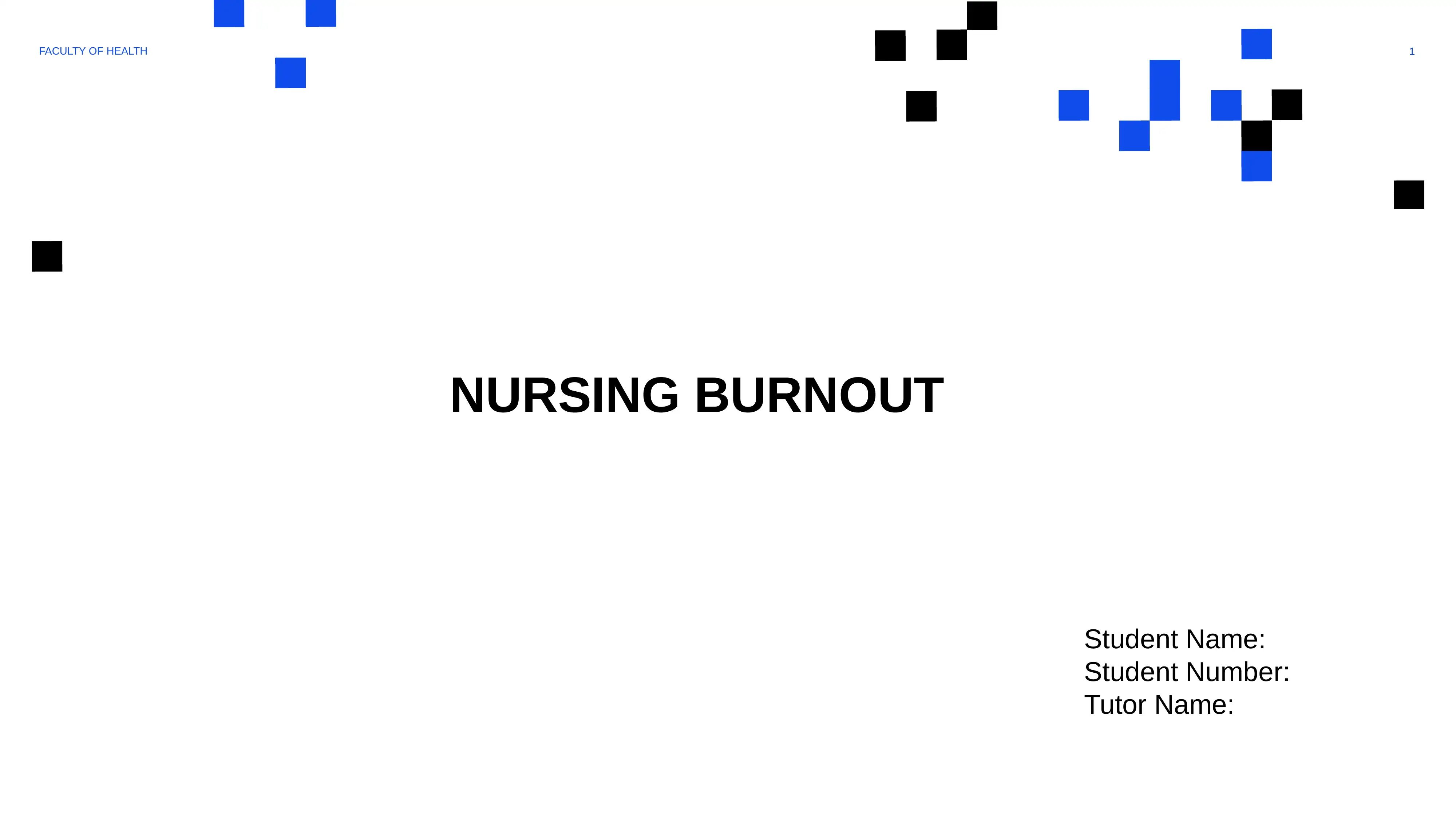
1FACULTY OF HEALTH
NURSING BURNOUT
Student Name:
Student Number:
Tutor Name:
NURSING BURNOUT
Student Name:
Student Number:
Tutor Name:
Paraphrase This Document
Need a fresh take? Get an instant paraphrase of this document with our AI Paraphraser
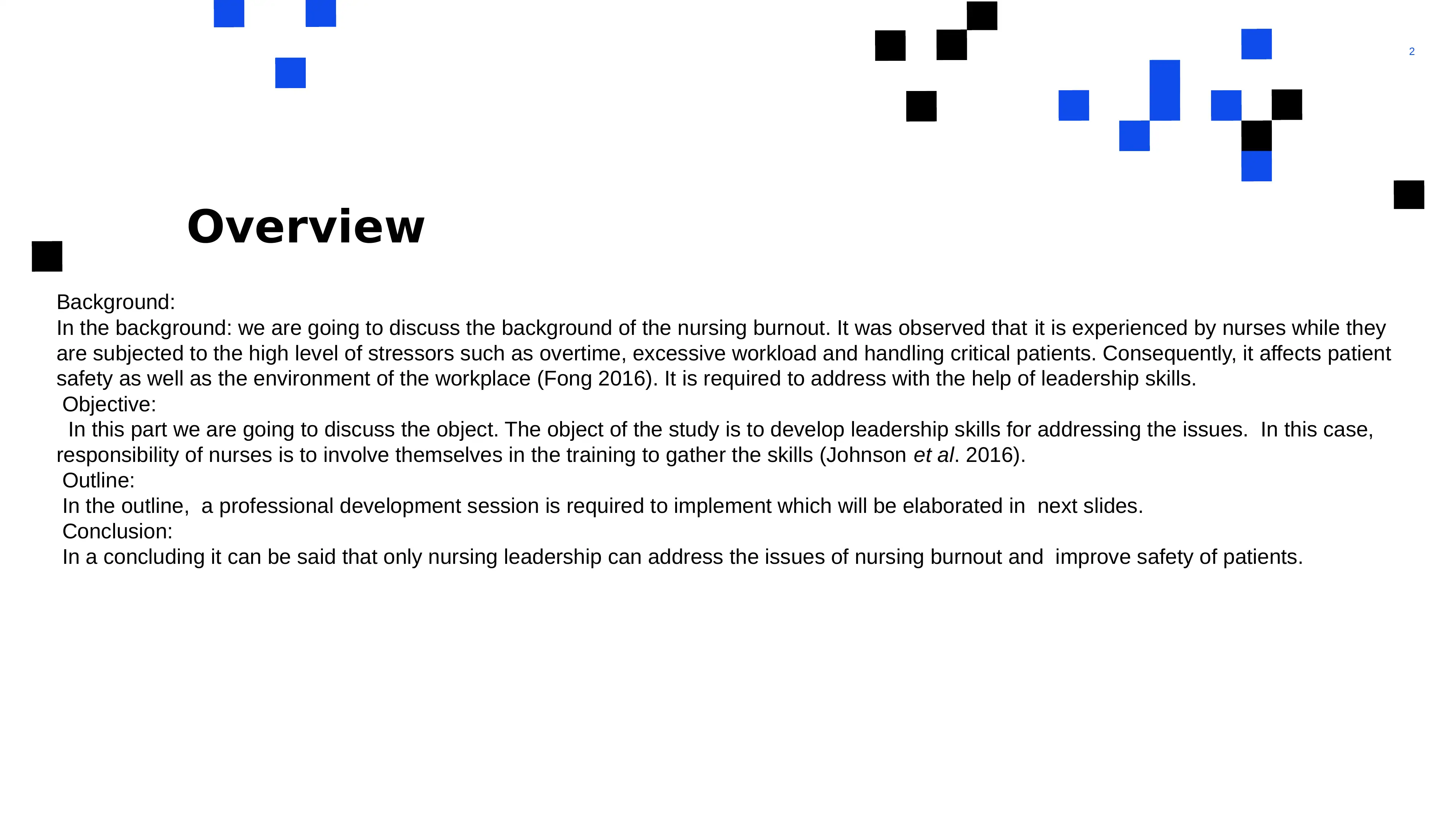
2
Overview
Background:
In the background: we are going to discuss the background of the nursing burnout. It was observed that it is experienced by nurses while they
are subjected to the high level of stressors such as overtime, excessive workload and handling critical patients. Consequently, it affects patient
safety as well as the environment of the workplace (Fong 2016). It is required to address with the help of leadership skills.
Objective:
In this part we are going to discuss the object. The object of the study is to develop leadership skills for addressing the issues. In this case,
responsibility of nurses is to involve themselves in the training to gather the skills (Johnson et al. 2016).
Outline:
In the outline, a professional development session is required to implement which will be elaborated in next slides.
Conclusion:
In a concluding it can be said that only nursing leadership can address the issues of nursing burnout and improve safety of patients.
Overview
Background:
In the background: we are going to discuss the background of the nursing burnout. It was observed that it is experienced by nurses while they
are subjected to the high level of stressors such as overtime, excessive workload and handling critical patients. Consequently, it affects patient
safety as well as the environment of the workplace (Fong 2016). It is required to address with the help of leadership skills.
Objective:
In this part we are going to discuss the object. The object of the study is to develop leadership skills for addressing the issues. In this case,
responsibility of nurses is to involve themselves in the training to gather the skills (Johnson et al. 2016).
Outline:
In the outline, a professional development session is required to implement which will be elaborated in next slides.
Conclusion:
In a concluding it can be said that only nursing leadership can address the issues of nursing burnout and improve safety of patients.
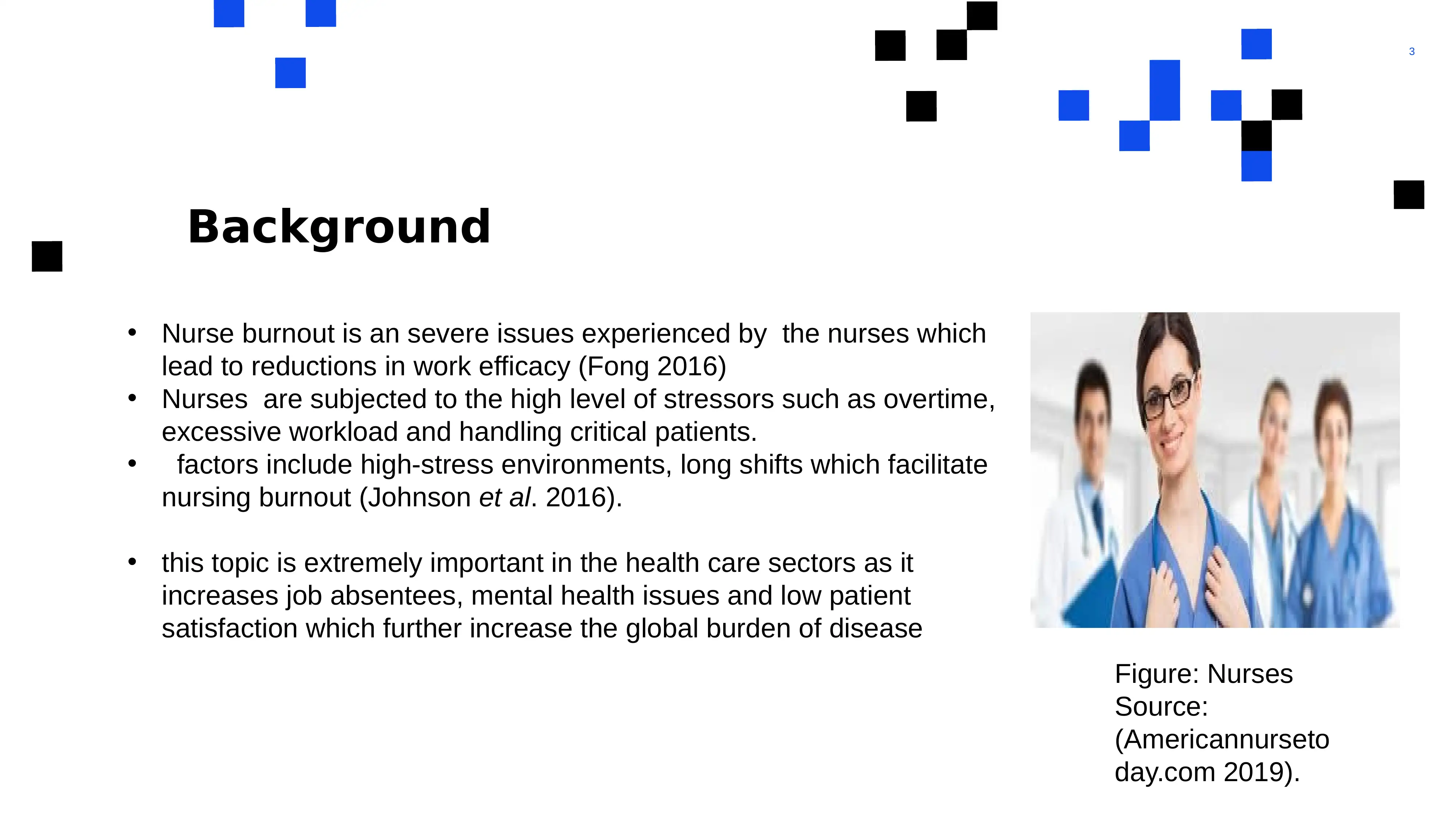
3
Background
• Nurse burnout is an severe issues experienced by the nurses which
lead to reductions in work efficacy (Fong 2016)
• Nurses are subjected to the high level of stressors such as overtime,
excessive workload and handling critical patients.
• factors include high-stress environments, long shifts which facilitate
nursing burnout (Johnson et al. 2016).
• this topic is extremely important in the health care sectors as it
increases job absentees, mental health issues and low patient
satisfaction which further increase the global burden of disease
Figure: Nurses
Source:
(Americannurseto
day.com 2019).
Background
• Nurse burnout is an severe issues experienced by the nurses which
lead to reductions in work efficacy (Fong 2016)
• Nurses are subjected to the high level of stressors such as overtime,
excessive workload and handling critical patients.
• factors include high-stress environments, long shifts which facilitate
nursing burnout (Johnson et al. 2016).
• this topic is extremely important in the health care sectors as it
increases job absentees, mental health issues and low patient
satisfaction which further increase the global burden of disease
Figure: Nurses
Source:
(Americannurseto
day.com 2019).
⊘ This is a preview!⊘
Do you want full access?
Subscribe today to unlock all pages.

Trusted by 1+ million students worldwide
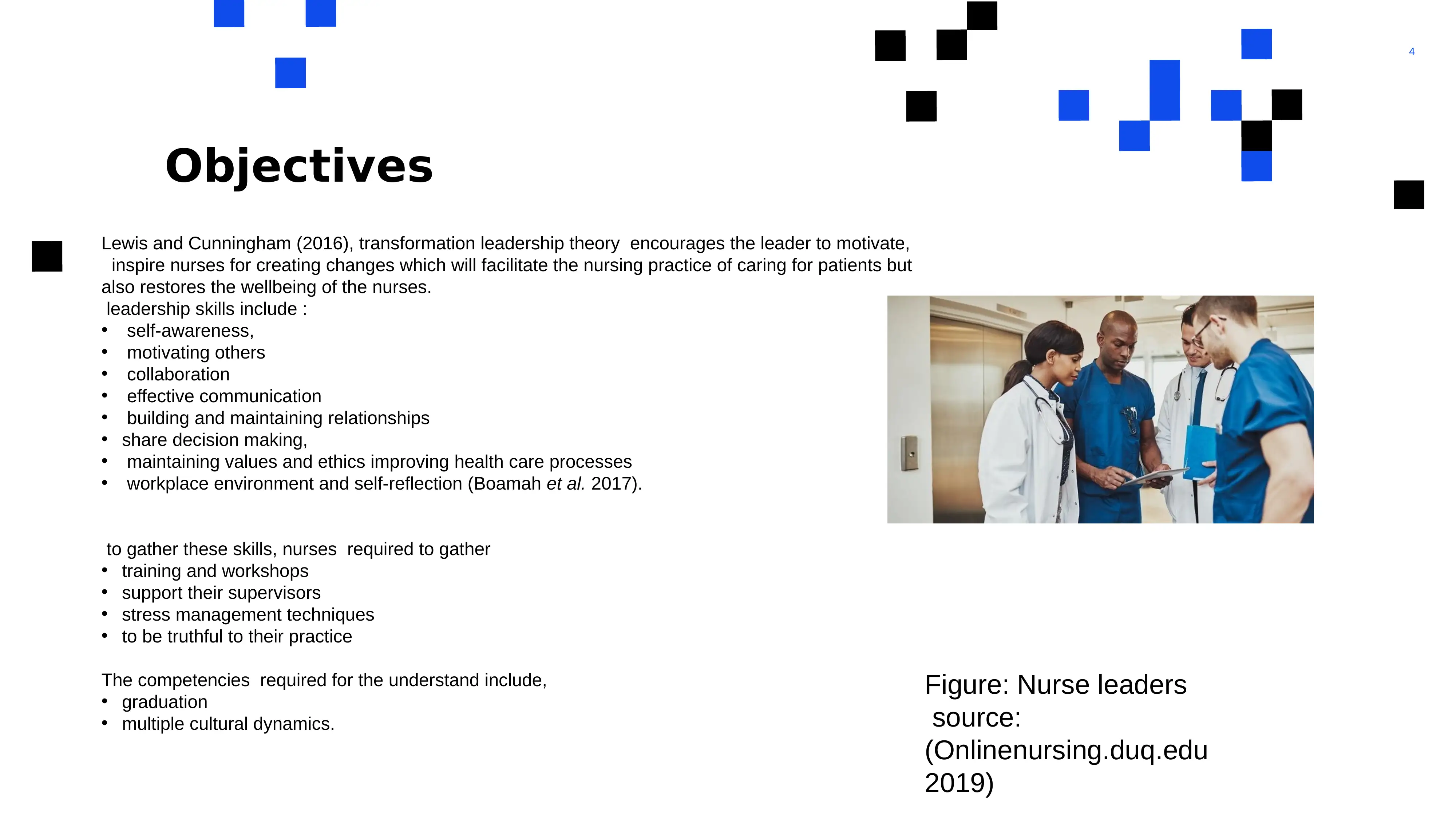
4
Objectives
Lewis and Cunningham (2016), transformation leadership theory encourages the leader to motivate,
inspire nurses for creating changes which will facilitate the nursing practice of caring for patients but
also restores the wellbeing of the nurses.
leadership skills include :
• self-awareness,
• motivating others
• collaboration
• effective communication
• building and maintaining relationships
• share decision making,
• maintaining values and ethics improving health care processes
• workplace environment and self-reflection (Boamah et al. 2017).
to gather these skills, nurses required to gather
• training and workshops
• support their supervisors
• stress management techniques
• to be truthful to their practice
The competencies required for the understand include,
• graduation
• multiple cultural dynamics.
Figure: Nurse leaders
source:
(Onlinenursing.duq.edu
2019)
Objectives
Lewis and Cunningham (2016), transformation leadership theory encourages the leader to motivate,
inspire nurses for creating changes which will facilitate the nursing practice of caring for patients but
also restores the wellbeing of the nurses.
leadership skills include :
• self-awareness,
• motivating others
• collaboration
• effective communication
• building and maintaining relationships
• share decision making,
• maintaining values and ethics improving health care processes
• workplace environment and self-reflection (Boamah et al. 2017).
to gather these skills, nurses required to gather
• training and workshops
• support their supervisors
• stress management techniques
• to be truthful to their practice
The competencies required for the understand include,
• graduation
• multiple cultural dynamics.
Figure: Nurse leaders
source:
(Onlinenursing.duq.edu
2019)
Paraphrase This Document
Need a fresh take? Get an instant paraphrase of this document with our AI Paraphraser
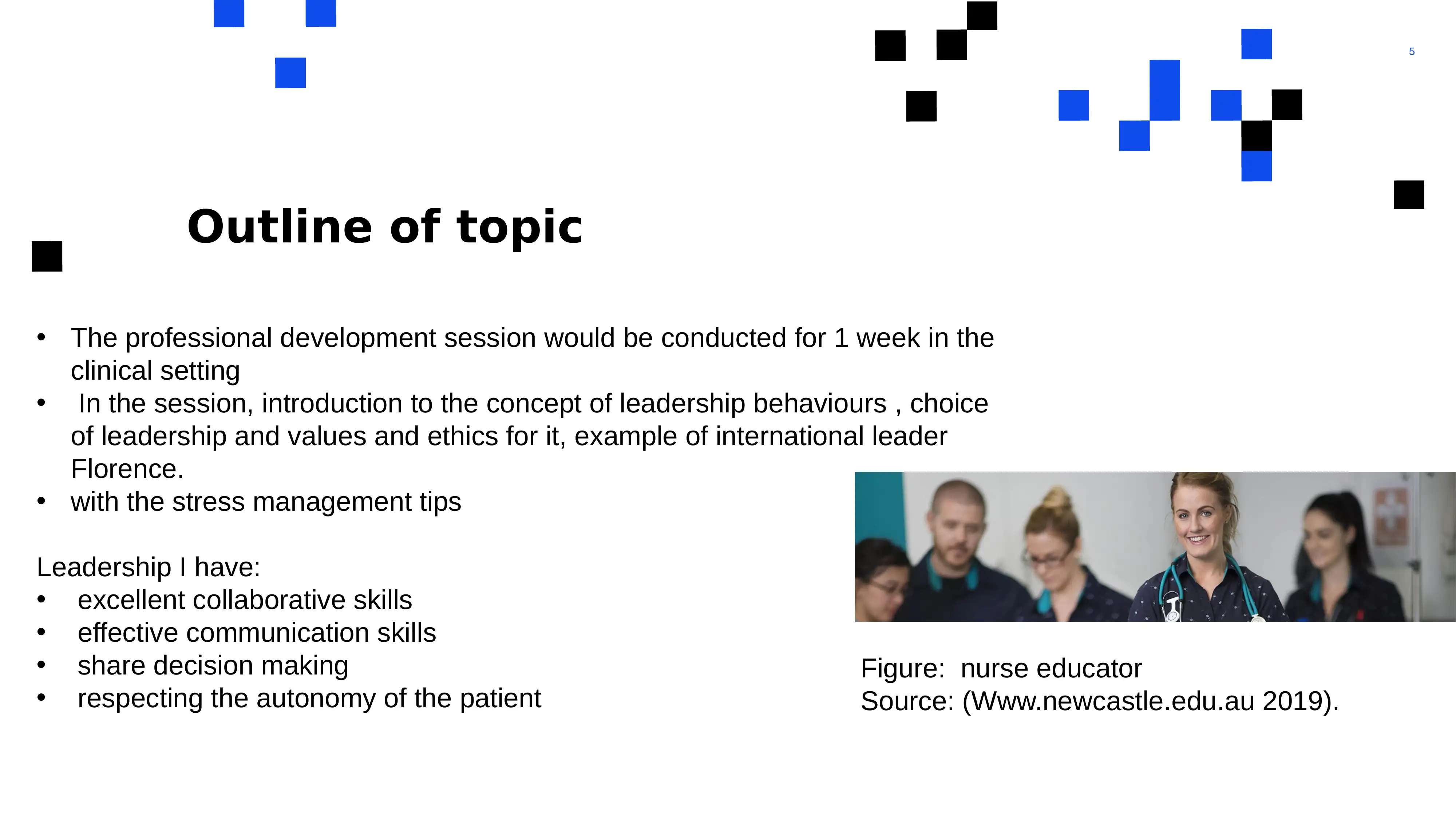
5
Outline of topic
• The professional development session would be conducted for 1 week in the
clinical setting
• In the session, introduction to the concept of leadership behaviours , choice
of leadership and values and ethics for it, example of international leader
Florence.
• with the stress management tips
Leadership I have:
• excellent collaborative skills
• effective communication skills
• share decision making
• respecting the autonomy of the patient
Figure: nurse educator
Source: (Www.newcastle.edu.au 2019).
Outline of topic
• The professional development session would be conducted for 1 week in the
clinical setting
• In the session, introduction to the concept of leadership behaviours , choice
of leadership and values and ethics for it, example of international leader
Florence.
• with the stress management tips
Leadership I have:
• excellent collaborative skills
• effective communication skills
• share decision making
• respecting the autonomy of the patient
Figure: nurse educator
Source: (Www.newcastle.edu.au 2019).
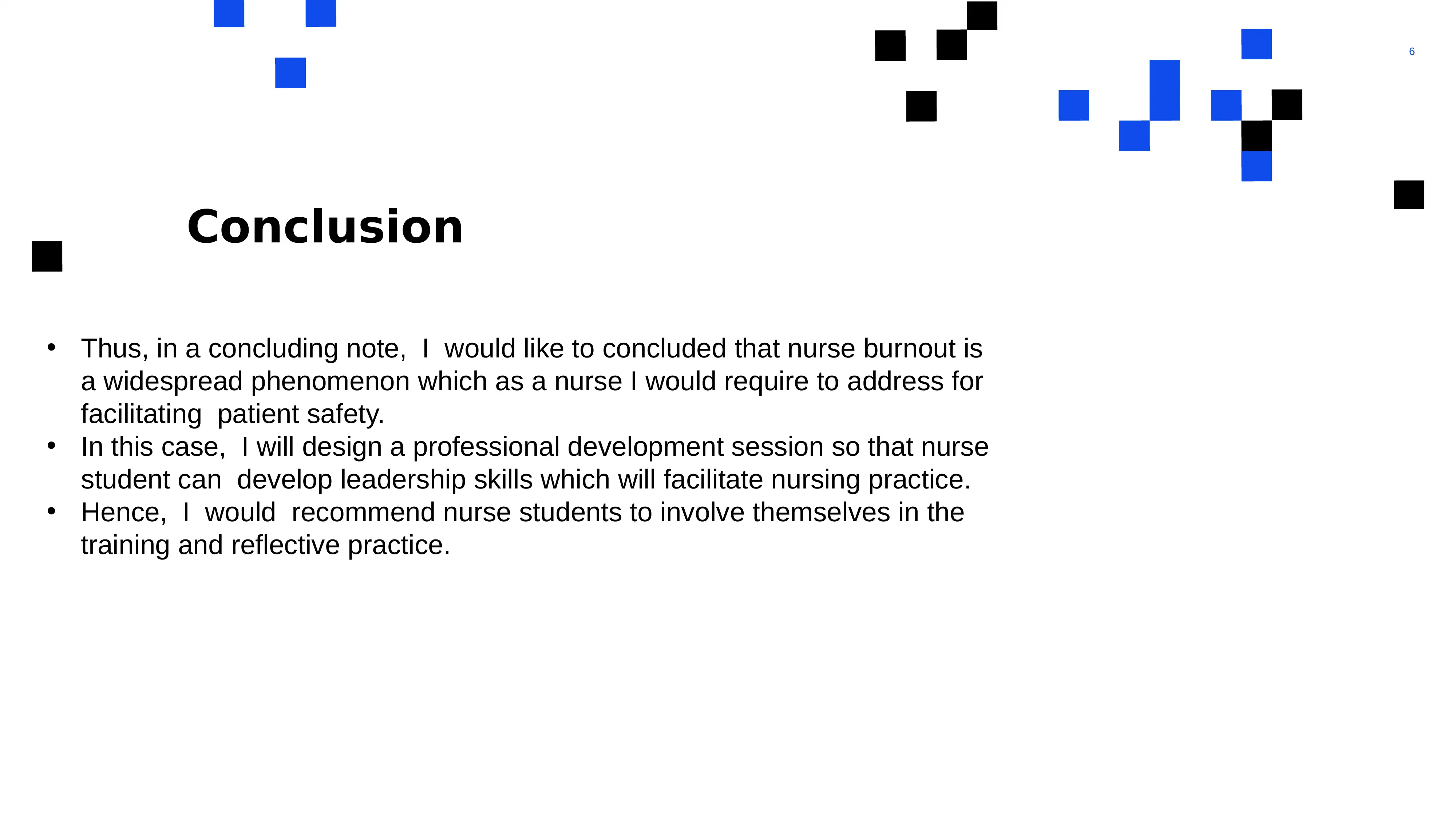
6
Conclusion
• Thus, in a concluding note, I would like to concluded that nurse burnout is
a widespread phenomenon which as a nurse I would require to address for
facilitating patient safety.
• In this case, I will design a professional development session so that nurse
student can develop leadership skills which will facilitate nursing practice.
• Hence, I would recommend nurse students to involve themselves in the
training and reflective practice.
Conclusion
• Thus, in a concluding note, I would like to concluded that nurse burnout is
a widespread phenomenon which as a nurse I would require to address for
facilitating patient safety.
• In this case, I will design a professional development session so that nurse
student can develop leadership skills which will facilitate nursing practice.
• Hence, I would recommend nurse students to involve themselves in the
training and reflective practice.
⊘ This is a preview!⊘
Do you want full access?
Subscribe today to unlock all pages.

Trusted by 1+ million students worldwide
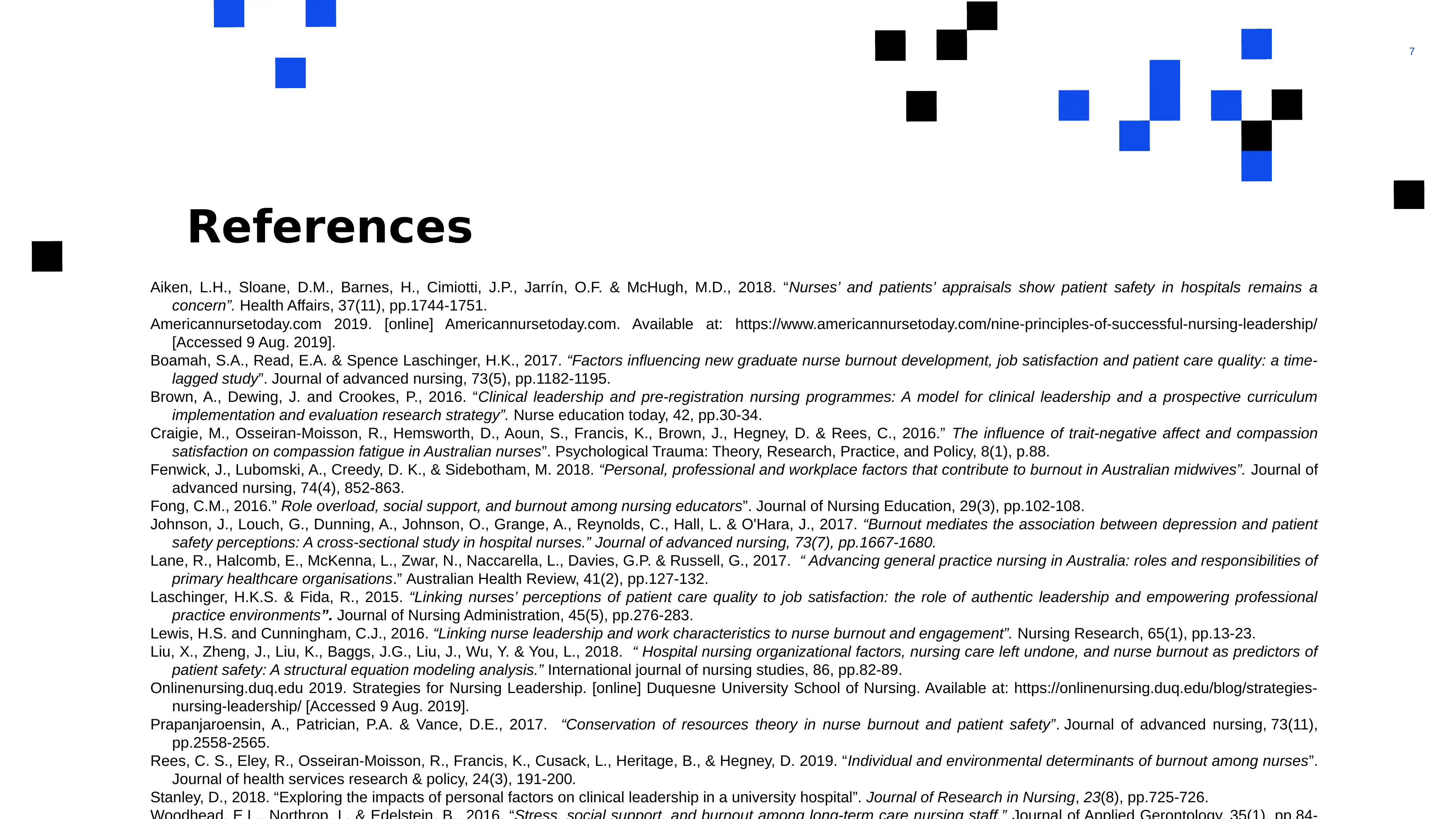
7
References
Aiken, L.H., Sloane, D.M., Barnes, H., Cimiotti, J.P., Jarrín, O.F. & McHugh, M.D., 2018. “Nurses’ and patients’ appraisals show patient safety in hospitals remains a
concern”. Health Affairs, 37(11), pp.1744-1751.
Americannursetoday.com 2019. [online] Americannursetoday.com. Available at: https://www.americannursetoday.com/nine-principles-of-successful-nursing-leadership/
[Accessed 9 Aug. 2019].
Boamah, S.A., Read, E.A. & Spence Laschinger, H.K., 2017. “Factors influencing new graduate nurse burnout development, job satisfaction and patient care quality: a time‐
lagged study”. Journal of advanced nursing, 73(5), pp.1182-1195.
Brown, A., Dewing, J. and Crookes, P., 2016. “Clinical leadership and pre-registration nursing programmes: A model for clinical leadership and a prospective curriculum
implementation and evaluation research strategy”. Nurse education today, 42, pp.30-34.
Craigie, M., Osseiran-Moisson, R., Hemsworth, D., Aoun, S., Francis, K., Brown, J., Hegney, D. & Rees, C., 2016.” The influence of trait-negative affect and compassion
satisfaction on compassion fatigue in Australian nurses”. Psychological Trauma: Theory, Research, Practice, and Policy, 8(1), p.88.
Fenwick, J., Lubomski, A., Creedy, D. K., & Sidebotham, M. 2018. “Personal, professional and workplace factors that contribute to burnout in Australian midwives”. Journal of
advanced nursing, 74(4), 852-863.
Fong, C.M., 2016.” Role overload, social support, and burnout among nursing educators”. Journal of Nursing Education, 29(3), pp.102-108.
Johnson, J., Louch, G., Dunning, A., Johnson, O., Grange, A., Reynolds, C., Hall, L. & O'Hara, J., 2017. “Burnout mediates the association between depression and patient
safety perceptions: A cross‐sectional study in hospital nurses.” Journal of advanced nursing, 73(7), pp.1667-1680.
Lane, R., Halcomb, E., McKenna, L., Zwar, N., Naccarella, L., Davies, G.P. & Russell, G., 2017. “ Advancing general practice nursing in Australia: roles and responsibilities of
primary healthcare organisations.” Australian Health Review, 41(2), pp.127-132.
Laschinger, H.K.S. & Fida, R., 2015. “Linking nurses’ perceptions of patient care quality to job satisfaction: the role of authentic leadership and empowering professional
practice environments”. Journal of Nursing Administration, 45(5), pp.276-283.
Lewis, H.S. and Cunningham, C.J., 2016. “Linking nurse leadership and work characteristics to nurse burnout and engagement”. Nursing Research, 65(1), pp.13-23.
Liu, X., Zheng, J., Liu, K., Baggs, J.G., Liu, J., Wu, Y. & You, L., 2018. “ Hospital nursing organizational factors, nursing care left undone, and nurse burnout as predictors of
patient safety: A structural equation modeling analysis.” International journal of nursing studies, 86, pp.82-89.
Onlinenursing.duq.edu 2019. Strategies for Nursing Leadership. [online] Duquesne University School of Nursing. Available at: https://onlinenursing.duq.edu/blog/strategies-
nursing-leadership/ [Accessed 9 Aug. 2019].
Prapanjaroensin, A., Patrician, P.A. & Vance, D.E., 2017. “Conservation of resources theory in nurse burnout and patient safety”. Journal of advanced nursing, 73(11),
pp.2558-2565.
Rees, C. S., Eley, R., Osseiran-Moisson, R., Francis, K., Cusack, L., Heritage, B., & Hegney, D. 2019. “Individual and environmental determinants of burnout among nurses”.
Journal of health services research & policy, 24(3), 191-200.
Stanley, D., 2018. “Exploring the impacts of personal factors on clinical leadership in a university hospital”. Journal of Research in Nursing, 23(8), pp.725-726.
References
Aiken, L.H., Sloane, D.M., Barnes, H., Cimiotti, J.P., Jarrín, O.F. & McHugh, M.D., 2018. “Nurses’ and patients’ appraisals show patient safety in hospitals remains a
concern”. Health Affairs, 37(11), pp.1744-1751.
Americannursetoday.com 2019. [online] Americannursetoday.com. Available at: https://www.americannursetoday.com/nine-principles-of-successful-nursing-leadership/
[Accessed 9 Aug. 2019].
Boamah, S.A., Read, E.A. & Spence Laschinger, H.K., 2017. “Factors influencing new graduate nurse burnout development, job satisfaction and patient care quality: a time‐
lagged study”. Journal of advanced nursing, 73(5), pp.1182-1195.
Brown, A., Dewing, J. and Crookes, P., 2016. “Clinical leadership and pre-registration nursing programmes: A model for clinical leadership and a prospective curriculum
implementation and evaluation research strategy”. Nurse education today, 42, pp.30-34.
Craigie, M., Osseiran-Moisson, R., Hemsworth, D., Aoun, S., Francis, K., Brown, J., Hegney, D. & Rees, C., 2016.” The influence of trait-negative affect and compassion
satisfaction on compassion fatigue in Australian nurses”. Psychological Trauma: Theory, Research, Practice, and Policy, 8(1), p.88.
Fenwick, J., Lubomski, A., Creedy, D. K., & Sidebotham, M. 2018. “Personal, professional and workplace factors that contribute to burnout in Australian midwives”. Journal of
advanced nursing, 74(4), 852-863.
Fong, C.M., 2016.” Role overload, social support, and burnout among nursing educators”. Journal of Nursing Education, 29(3), pp.102-108.
Johnson, J., Louch, G., Dunning, A., Johnson, O., Grange, A., Reynolds, C., Hall, L. & O'Hara, J., 2017. “Burnout mediates the association between depression and patient
safety perceptions: A cross‐sectional study in hospital nurses.” Journal of advanced nursing, 73(7), pp.1667-1680.
Lane, R., Halcomb, E., McKenna, L., Zwar, N., Naccarella, L., Davies, G.P. & Russell, G., 2017. “ Advancing general practice nursing in Australia: roles and responsibilities of
primary healthcare organisations.” Australian Health Review, 41(2), pp.127-132.
Laschinger, H.K.S. & Fida, R., 2015. “Linking nurses’ perceptions of patient care quality to job satisfaction: the role of authentic leadership and empowering professional
practice environments”. Journal of Nursing Administration, 45(5), pp.276-283.
Lewis, H.S. and Cunningham, C.J., 2016. “Linking nurse leadership and work characteristics to nurse burnout and engagement”. Nursing Research, 65(1), pp.13-23.
Liu, X., Zheng, J., Liu, K., Baggs, J.G., Liu, J., Wu, Y. & You, L., 2018. “ Hospital nursing organizational factors, nursing care left undone, and nurse burnout as predictors of
patient safety: A structural equation modeling analysis.” International journal of nursing studies, 86, pp.82-89.
Onlinenursing.duq.edu 2019. Strategies for Nursing Leadership. [online] Duquesne University School of Nursing. Available at: https://onlinenursing.duq.edu/blog/strategies-
nursing-leadership/ [Accessed 9 Aug. 2019].
Prapanjaroensin, A., Patrician, P.A. & Vance, D.E., 2017. “Conservation of resources theory in nurse burnout and patient safety”. Journal of advanced nursing, 73(11),
pp.2558-2565.
Rees, C. S., Eley, R., Osseiran-Moisson, R., Francis, K., Cusack, L., Heritage, B., & Hegney, D. 2019. “Individual and environmental determinants of burnout among nurses”.
Journal of health services research & policy, 24(3), 191-200.
Stanley, D., 2018. “Exploring the impacts of personal factors on clinical leadership in a university hospital”. Journal of Research in Nursing, 23(8), pp.725-726.
1 out of 7
Your All-in-One AI-Powered Toolkit for Academic Success.
+13062052269
info@desklib.com
Available 24*7 on WhatsApp / Email
![[object Object]](/_next/static/media/star-bottom.7253800d.svg)
Unlock your academic potential
Copyright © 2020–2025 A2Z Services. All Rights Reserved. Developed and managed by ZUCOL.

